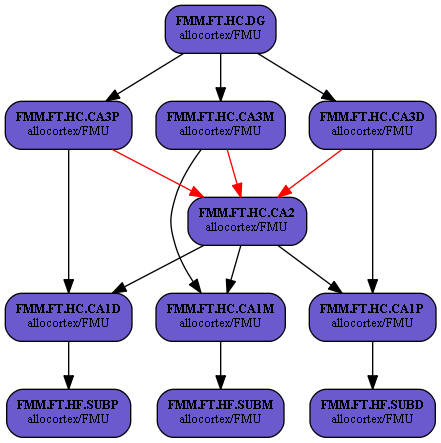Difference between revisions of "BrainCenterFMM FT HF"
From aHuman Wiki
(Automated page entry using MWPush.pl) |
(Automated page entry using MWPush.pl) |
||
| Line 118: | Line 118: | ||
| [[BrainCenterFAM_FT_SEP|Septal Nuclei]] (FAM.FT.SEP) || [[BrainRegionFMM_FT_HC_CA1D|FMM.FT.HC.CA1D]] -> [[BrainRegionFAM_FT_SEP_LT|FAM.FT.SEP.LT]]||[http://jn.physiology.org/content/107/10/2633 Connectivity map of the habenula (Hippo -> Septum, abstract)] | | [[BrainCenterFAM_FT_SEP|Septal Nuclei]] (FAM.FT.SEP) || [[BrainRegionFMM_FT_HC_CA1D|FMM.FT.HC.CA1D]] -> [[BrainRegionFAM_FT_SEP_LT|FAM.FT.SEP.LT]]||[http://jn.physiology.org/content/107/10/2633 Connectivity map of the habenula (Hippo -> Septum, abstract)] | ||
|- | |- | ||
| − | | [[BrainCenterFD_HT|Hypothalamus]] (FD.HT) || [[BrainRegionFMM_FT_HC_CA1D|FMM.FT.HC.CA1D]] -> [[ | + | | [[BrainCenterFD_HT|Hypothalamus]] (FD.HT) || [[BrainRegionFMM_FT_HC_CA1D|FMM.FT.HC.CA1D]] -> [[BrainRegionLAC_FD_HT_MPO|LAC.FD.HT.MPO]]||[http://www.nature.com/nrn/journal/v5/n7 Feeling (HC -> HT, abstract)] |
|- | |- | ||
| [[BrainCenterFD_TH_CR|Cognitive Thalamus]] (FD.TH.CR) || [[BrainRegionFMM_FT_HF_SUBD|FMM.FT.HF.SUBD]] -> [[BrainRegionFMM_FD_TH_AV|FMM.FD.TH.AV]]||[http://what-when-how.com/neuroscience/the-thalamus-and-cerebral-cortex-integrative-systems-part-2/ Thalamocortical relationships (s1A -> A, abstract)] | | [[BrainCenterFD_TH_CR|Cognitive Thalamus]] (FD.TH.CR) || [[BrainRegionFMM_FT_HF_SUBD|FMM.FT.HF.SUBD]] -> [[BrainRegionFMM_FD_TH_AV|FMM.FD.TH.AV]]||[http://what-when-how.com/neuroscience/the-thalamus-and-cerebral-cortex-integrative-systems-part-2/ Thalamocortical relationships (s1A -> A, abstract)] | ||
Revision as of 09:50, 10 September 2015
Hippocampal Formation
@@Home -> BiologicalLifeResearch -> BrainCenterFMM_FT_HF
This page covers biological details of component group Hippocampal Formation. Component group is part of aHuman target integrated biological model.
- Top-down path to center: Forebrain Telencephalon -> Hippocampal Formation (FMM.FT.HF) (see Mind Maps)
- Function: Attention and short-term to long-term memory conversion
- Notes to function: allocortex
(generated)
Components
(generated)
Component items:
- Hippocampus (FMM.FT.HC)
- Dentate Gyrus (FMM.FT.HC.DG): Distinguishing multiple instances of similar events
- Ventrolateral Cornu Ammonis of Hippocampus (FMM.FT.HC.CA1): Representing sequences of episodic memory - long-term
- Proximal CA1 of Hippocampus (FMM.FT.HC.CA1P): Long-term memory, spatial
- Middle CA1 of Hippocampus (FMM.FT.HC.CA1M): Long-term memory, synchronize
- Distal CA1 of Hippocampus (FMM.FT.HC.CA1D): Long-term memory, motivational
- Dorsolateral Cornu Ammonis of Hippocampus (FMM.FT.HC.CA2): Gate controlled by the activity of the supramammillary nucleus to control signal propagation between HC lamines
- Dorsomedial Cornu Ammonis of Hippocampus (FMM.FT.HC.CA3): Representing sequences of episodic memory - short-term
- Proximal CA3 of Hippocampus (FMM.FT.HC.CA3P): Representing sequences of episodic memory, spatial
- Middle CA3 of Hippocampus (FMM.FT.HC.CA3M): Representing sequences of episodic memory, synchronize
- Distal CA3 of Hippocampus (FMM.FT.HC.CA3D): Representing sequences of episodic memory, motivational
- Subiculum (FMM.FT.HF.SUB): Spatial navigation and mnemonic processing
- Proximal Subiculum (FMM.FT.HF.SUBP): Controlling hypothalamic-pituitary-adrenal (HPA) axis
- Middle Subiculum (FMM.FT.HF.SUBM): Dynamic bridging of temporal intervals
- Distal Subiculum (FMM.FT.HF.SUBD): Providing coarse representation of space
Connectivity
(generated)
Internal Regions Connections:

External Connections:

External Inbound Center Connections:
External Outbound Center Connections: